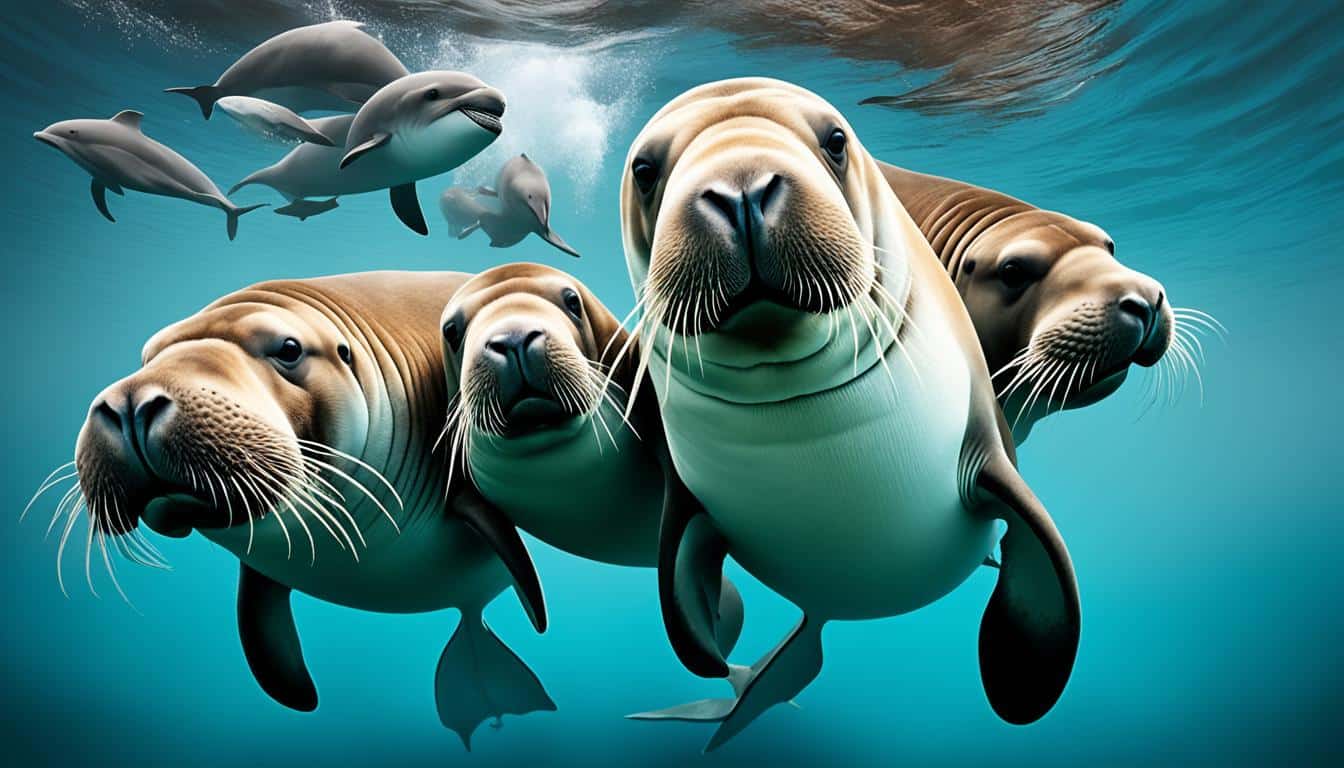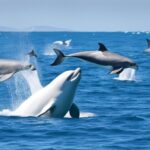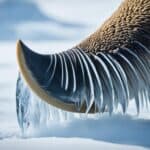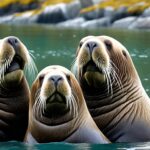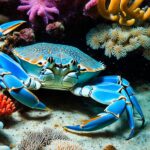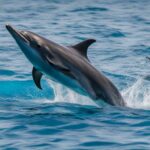Exploring how walruses interact with other sea creatures is truly fascinating. These huge animals have unique ways of living in the ocean. Their social behaviors and how they adapt show us a lot about their survival in changing environments.
This article will show you how walruses communicate with other sea animals to survive. They have complex social lives and interact with many marine species. Their behaviors highlight the intricate balance of life in the Arctic oceans.
Understanding Walrus Behavior with Other Sea Creatures
Walruses show interesting behavior when they meet other sea creatures. They often come together in big groups called haulouts. These groups can have a few dozen to thousands of walruses, leading to complex social life and breeding.
They have big tusks that are very important for their social life. These tusks help them fight, show who’s boss, and get out of the water onto ice. Knowing how walrus behavior with other sea creatures works means understanding the role of these tusks.
Walruses also have sensitive whiskers that help them find food on the ocean floor. This lets them work with other sea life, like seals and certain invertebrates. These interactions show the complex marine relationships of walruses in their home.
Walrus Social Interactions in the Ocean
Walruses live in groups that are key to their daily life. These groups have clear leaders based on size and tusk size. Male walruses, or bulls, show off their strength to get ahead, especially when finding a mate.
Female walruses protect their young, showing how important it is to keep the next generation safe. These behaviors are vital for the survival of the young and breeding success. They also help protect the group from dangers like polar bears and orcas.
This way of staying safe shows how important it is for walruses to communicate with other sea creatures. Their social life helps them survive and builds a complex network in the ocean.
How do walruses interact with other marine life?
Walruses have complex interactions with many marine animals. Their tusks play a big role in these interactions. These tusks help them in physical tasks and are key in setting social order in groups.
The Role of Tusks in Interactions
Tusks are crucial for walruses when dealing with other marine animals. They help them get onto ice and are used in social behaviors during mating. In fights for dominance, tusks are key, affecting who gets the best resources and mates.
Social Hierarchies Within Groups
In walrus groups, social order is important. Bigger, older males get the best spots and mates. This leads to complex social behaviors, especially in the breeding season. It shows how walruses compete with other marine animals for survival.
| Social Structure | Dominant Males | Access to Resources | Impact on Breeding |
|---|---|---|---|
| Hierarchy Levels | More opportunities | Prime foraging spots | Higher mating success |
| Competition | Frequent challenges | Limited access for subordinates | Increased aggression |
| Group Dynamics | Social bonds | Shared resources | Stronger kin relationships |
Walrus Habitat and Marine Life Interactions
The walrus’s home is key to its complex relationships with other sea creatures. They need stable sea ice for resting, breeding, and taking care of their young. Knowing how walruses live shows us the balance in the ocean.
This balance is crucial for a healthy ocean.
Importance of Sea Ice for Walrus Activities
Sea ice is crucial for walruses. It gives them a safe place to have their young and rest. This ice also helps them save energy by giving them a place to rest between hunting trips.
This shows how important ice is for walruses and other sea creatures.
Impact of Climate Change on Marine Relationships
Climate change is changing the walrus’s home, affecting their friends in the sea. Without sea ice, walruses have to rest on land more. This can lead to fights over food with other animals.
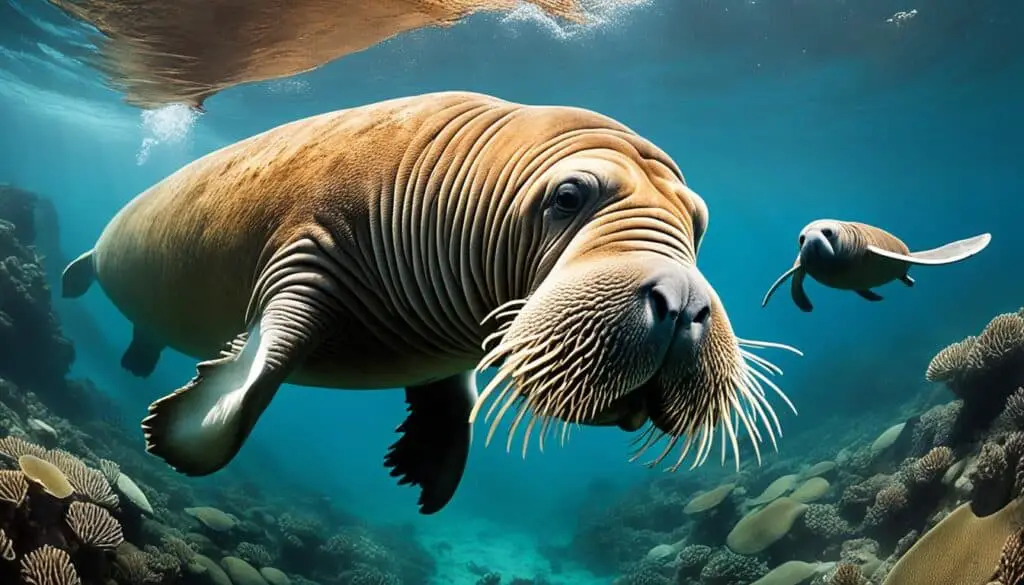
| Aspect | Importance for Walruses | Effect of Climate Change |
|---|---|---|
| Sea Ice | Platform for resting, breeding, and nurturing young | Loss of stable ice leads to increased land resting |
| Foraging Opportunities | Maximizes energy efficiency | Reduced feeding efficiency as food distribution changes |
| Competition | Maintains balance among species | Heightened competition for food resources with other species |
Walrus Communication with Sea Creatures
Walruses have interesting ways to talk to sea creatures. Learning about their communication helps us understand their role in the ocean. They use sounds and signals, and even their whiskers, to talk to others.
Vocalizations and Other Signals
Walruses make many sounds to talk to each other. They bark, grunt, and bellow for different reasons, like when they’re together or eating. These sounds show their feelings and help them stay connected in groups. It shows how complex their social lives are.
Whiskers as Sensory Tools in Interactions
Walruses also use their whiskers to feel their way around. These whiskers help them find food on the ocean floor and sense water movements. They use these skills to talk to each other and other sea animals without making a sound. This shows how smart walrus communication is.
| Type of Communication | Example | Purpose |
|---|---|---|
| Vocalizations | Barks | Social bonding, warning |
| Vocalizations | Grunts | Feeding coordination |
| Body Language | Positioning | Establishing hierarchy |
| Sensory Tools | Whisker movements | Food detection, navigation |
Walruses and Other Marine Species Interactions
Understanding how walruses interact with other marine species is key to knowing the ocean’s complex life. They mainly eat soft-shelled creatures like clams, pulling them from the ocean floor with their whiskers. This affects the numbers of these invertebrates, changing the ecosystem’s balance.
Walruses also have a role as both hunters and hunted in the sea. They can protect other sea creatures from orcas, keeping them safe. But, they also hunt smaller animals, like seals or seabirds, which can upset the balance of food chains.
Studying walrus interactions in the sea helps us understand their impact on marine life. By looking into these relationships, we learn about the delicate balance of marine ecosystems. This shows us how walrus behavior affects the ocean’s wider world.
FAQ
How do walruses interact with other marine life?
Walruses live in large groups called haulouts. They have complex social behaviors and ways of communicating. They also hunt and compete for food, showing how they fit into marine ecosystems.
What is the role of tusks in walrus interactions?
Tusks are key in walrus social life. They help in mating fights and show who’s in charge. Tusks also help with tasks like getting out of the water onto ice.
How do walruses communicate with each other?
Walruses use sounds like barks and body language to talk to each other. Their whiskers help them find food and move around safely.
What are the social hierarchies among walruses?
In walrus groups, size and tusk size matter. Bigger males, or bulls, lead and fight for mates. This affects who gets to mate and access resources.
Why is sea ice important for walrus activities?
Sea ice is crucial for walruses. It’s where they rest, breed, and bond with their young. It also helps them find food. Climate change is threatening their homes.
How does climate change affect walrus interactions with marine life?
Climate change melts sea ice, changing walrus habitats. This makes them compete for food and can lead to conflicts with other animals. It also affects their social life and breeding.
What types of marine animals do walruses interact with?
Walruses eat soft-shelled invertebrates and sometimes seals and seabirds. They can change the behavior of other sea creatures. They can also be eaten by orcas.
How do walrus interactions contribute to marine ecosystems?
Walruses play a big part in marine ecosystems through their eating habits. They help keep the balance by eating certain species and competing for food. They are both predators and prey in the ocean.

